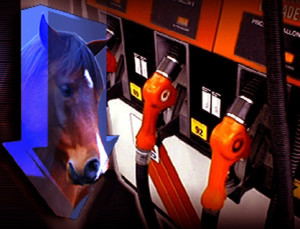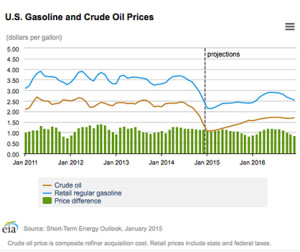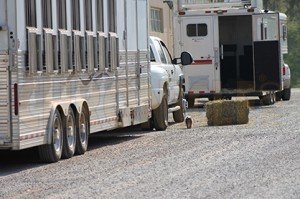Will the Decrease in Gas Prices be a Boost to the Horse Industry in 2015?
By: Brittany Bevis
The cost of gasoline and diesel here in the U.S. affects many different segments of the horse industry. For competitive equestrians, who transport their horses to events around the country, a spike in gas prices might restrict how much they can travel, how far they’re willing to travel, and consequently which horse shows they attend.
Fuel prices affect the everyday horse owner in the form of hay and grain production and transportation. Chances are that scoop of feed you gave your horse for breakfast this morning wasn’t grown and processed in your own backyard, or even the state where you live. Whether by train, plane, or automobile, the feed has to be shipped somehow; that’s where fuel prices come into play.
For those of you who rely on an outside training or boarding program, a change in fuel prices might even cause you to consider moving your horse closer to home. This could result in switching to a trainer in closer proximity as opposed to one you have to travel an hour or two away to visit every week.
The GOOD news is that regular gasoline prices in the U.S. fell from a monthly average of $3.69/gal in June 2014 to $2.54/gal in December 2014. That’s the lowest monthly average since July 2009, according to the U.S. Energy Information Administration. Furthermore, the EIA expects U.S. gasoline retail prices will fall to an average of $2.13/gal in January 2015. If you’ve been keeping an eye on the pumps in your area, you might have already noticed this change.
Even MORE GOOD news… according to the EIA, the average household is now expected to spend about $750 less for gasoline in 2015 than in 2014, because of lower prices. That equals a full month of board and a few training lessons in some parts of the country, or even a trip to a large breed circuit.
How did this trend happen and how long can we expect it to last? The funny thing about fuel is that’s it’s a liquid, not a solid, and fuel prices tend to adopt the same characteristics. Still, the latest predictions show that U.S. gasoline prices should remain low at an average of $2.33/gal for the remainder of the year.
We had the opportunity to chat with an EIA expert on the Liquid Fuels Markets Team, Sean Hill, to gain a bit more insight into how this drop in fuel prices could affect the horse industry in 2015.
“We expect [U.S. gas prices] to hit a low of $2.13/gal in February, before increasing slightly throughout the year as oil prices slowly creep back up in the second half of 2015 in our forecast,” Hill says. “The unknown factors that could change the gas price forecast are somewhat already unfolding, in that prices could continue to fall even lower.”
“Since we’ve finished our forecast, oil prices have tumbled another 4-5 dollars per barrel, which means gasoline prices are likely to continue to fall for the next week or two at least, potentially by another 10-15 cents/gal. At this point, the big uncertainty is at what price will oil prices finally stop falling, which seems to keep being pushed further downward each month. Brent oil prices have fallen by more than 50% since their June 2014 highs (at $112/barrel), so it’s been a pretty remarkable last few months.”
For those who rely on diesel for horsepower, there has been a considerable decrease as well, just not as much as gasoline. Diesel fuel retail prices averaged $3.83/gal in 2014 and are projected to fall to an average of $2.85/gal in 2015. However, they could rise back up to $3.25/gal in 2016.
Another interesting fact is that vehicle miles traveled were about 2% higher in the fourth quarter of 2014 as compared to the same period in 2013. It may not seem like a lot, however, the fourth quarter is typically the low demand time of the year for gasoline. Long story short, that means there has definitely been an increase in demand in response to the lower gas prices.
Although Hill doesn’t have any personal experience with agricultural transport costs, he was able to make a few predictions.
“While diesel fuel prices haven’t fallen to the extent that gasoline prices have, they are still considerably lower at the moment than they have been in roughly five years,” he says. “Diesel fuel prices averaged about 26% lower in 2014 than they did in 2013, and prices continue to fall. We don’t have any data on agricultural distribution costs, but it does make sense that you would see some savings in that department due to lower fuel prices.”
Interested in learning more? The most recent EIA Short-Term Energy Report was released yesterday. Click here to view the entire report. The next report will be released on Feb. 11, 2015. Scroll below to take a look at price changes in gasoline and diesel over the past two years and a prediction for 2015 and 2016.
Gasoline (dollars per gallon) avg. regular pump price
2013- $3.51
2014- $3.36
2015- $2.33
2016- $2.72
Diesel (Dollars per gallon)
2013- $3.92
2014- $3.83
2015- $2.85
2016- $3.25
FAQ’s
What’s up with gasoline prices?
Does EIA have gasoline prices by city, county, or zip code?
Why has diesel fuel been more expensive than gasoline?
Stay tuned for Part 2 and 3 in this series, where we will chat with a horse transportation expert to find out how fuel prices are affecting his business as well as a grain/hay producer to see if any of their savings might be passed on to you as the consumer.













